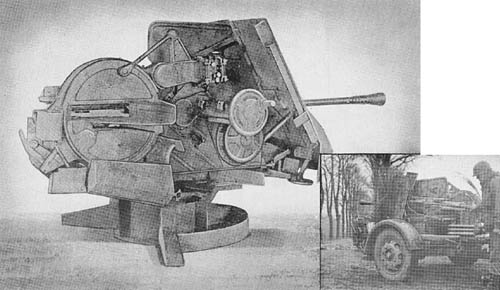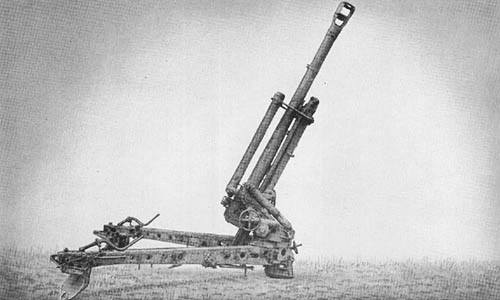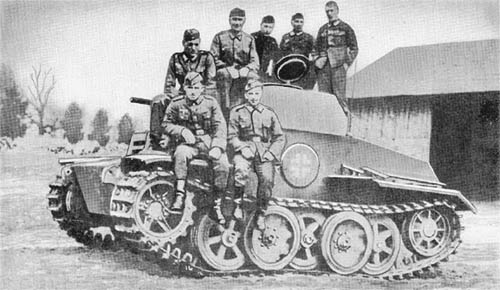
The 3.7 cm Flak 43, a light, fully-automatic, gas-operated antiaircraft weapon, may be statically emplaced, transported on a mobile mounting, or mounted on a self-propelled chassis. The gun consists of a removable, monobloc barrel fitted with a muzzle brake with six elongated ports and multi-perforated flash eliminator, and a breech casing which houses the breech mechanism. The gun is fed horizontally from the left in clips of eight rounds from a fixed loading tray, and is operated by the recoil of the gun itself. A hydro-spring buffer with variable recoil is located below the barrel, and two return springs lie side by side above the barrel.
Mounting is of the pedestal type, the gun being hung from a single-ring type trunnion on the right. The feed to the gun is mounted through the ring and on the axis of the trunnion, making unnecessary any alteration in the position of the center of gravity of the gun and other elevating parts with variation in the quantity of ammunition in the clips and feed mechanism. Elevating and traversing handwheels are both on the right of the gun, the former being vertical and the latter horizontal.
The equipment, which is of low build, is fitted with a shield varying in thickness from
The weapon fires only the single rotating band projectiles.
SPECIFICATIONS
| Caliber | 37 mm (1.45 ins.) | |
| Weight (traveling position) | 4,180 lbs. | |
| Weight (firing position) | 2,750 lbs. | |
| Length (traveling position) | ||
| Length (firing position) | ||
| Height (traveling position) | ||
| Height of trunnion | 29.9 ins. | |
| Length of piece (excluding muzzle brake) | 9.68 ft. | |
| Length of muzzle brake | 14.96 ins. | |
| Length of bore | 7 ft. | |
| No. of grooves | 20 | |
| Width of grooves | ||
| Depth of grooves | ||
| Width of lands | ||
| Muzzle velocity (HE shell) | 2,750 f/s | |
| Max. range (horizontal) | 7,200 yds. (approx.) | |
| Effective range (vertical) | 9,000 ft. (approx.) | |
| Rate of fire (theoretical) | 250 rds./min. | |
| (practical) | 150 rds./min. | |
| Traverse | 360° | |
| Elevation | 90° | |
| Depression | -6° | |
| Type of recoil | Variable | |
| Ammunition | AP/HE; H.E.; HE/T-HE/I/T; HE/I and HE/I/short T |
German: p. 130.2 (August 1, 1945)

